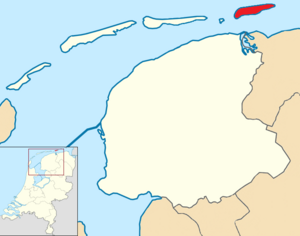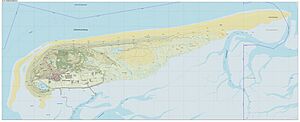Schiermonnikoog facts for kids
Quick facts for kids
Schiermonnikoog
Skiermûntseach
|
|||
|---|---|---|---|
|
North Tower
Ferry Schiermonnikoog
City Hall
Beach
|
|||
|
|||

Location in Friesland
|
|||
| Country | Netherlands | ||
| Province | Friesland | ||
| Government | |||
| • Body | Municipal council | ||
| Area | |||
| • Total | 199.07 km2 (76.86 sq mi) | ||
| • Land | 43.99 km2 (16.98 sq mi) | ||
| • Water | 155.08 km2 (59.88 sq mi) | ||
| Elevation | 4 m (13 ft) | ||
| Population
(May 2014)
|
|||
| • Total | 942 | ||
| • Density | 21/km2 (50/sq mi) | ||
| Demonym(s) | Schiermonnikoger | ||
| Time zone | UTC+1 (CET) | ||
| • Summer (DST) | UTC+2 (CEST) | ||
| Postcode |
9166
|
||
| Area code | 0519 | ||
Schiermonnikoog (Dutch: [ˌsxiːrmɔnəkˈoːx]; West Frisian: Skiermûntseach [ˌskiəmuːnˈtsɪəχ]) is an island, a municipality (a type of local government area), and a national park in the northern Netherlands. It is one of the West Frisian Islands and is part of the province of Friesland. The island is located between Ameland and Rottumerplaat.
Schiermonnikoog is about 16 km (9.9 mi) long and 4 km (2.5 mi) wide. It is home to the Netherlands' first national park. The only village on the island is also called Schiermonnikoog. Around 943 people live on the island all the time. This makes it the least populated and least densely populated municipality in the Netherlands.
Because the island is small and flat, only 200 islanders have a special permit to own a car. This means the few streets are almost car-free. About 300,000 people visit the island each year. They stay in holiday homes, apartments, and hotels, which have about 5,500 beds. Many visitors are day-trippers. About 4,000 people visit just for the day in July and August. After the last ferry leaves at 7:30 PM, the village high street becomes very quiet.
Contents
Island History: How Schiermonnikoog Got Its Name
The island of Schiermonnikoog is slowly moving south and east. This happens because of ocean currents, winds, and North Sea storms. In 1250, the island was about 2 km north of where it is today. Its shape was also very different back then.
The first time Schiermonnikoog was written about was in October 1440. This was in a document for Philip the Good. The first known owners of the island were monks from Klaarkamp Abbey. This was a Cistercian monastery on the mainland. The name Schiermonnikoog means Grey Monk Island. "Monnik" means "monk," "schier" is an old word for "grey," and "oog" means "island." The monks wore grey robes, which is how the island got its name.
Changes in Ownership and Village Life
During the Reformation, monasteries in the northern Netherlands were closed. In 1580, Schiermonnikoog became owned by the States of Friesland. Around 1640, the States sold the island to the rich Stachouwer family. For the next 300 years, Schiermonnikoog was private property.
Around 1700, the island had four villages. Westerburen was the largest. It grew around the old buildings of the grey monks. But in 1717 and 1720, big storms flooded Westerburen. The village had to be left empty around 1725 because of moving sand and the sea coming closer. In 1756, a new village called Oosterburen was built to the east. Today, this village is named Schiermonnikoog, just like the island.
In the 18th century, the islanders protested against Lady Catharina Maria Stachouwer. The States of Friesland sent soldiers to protect her and bring back order.
Schiermonnikoog During Wars
In August 1799, during the Napoleonic Wars, a small group of ships from Britain's Royal Navy attacked. They captured a ship called Crash near Schiermonnikoog. The British then attacked a Dutch ship and a gun battery on the island. They burned the ship and made the battery's guns unusable.
In 1859, the Stachouwer family sold the island to John Eric Banck from The Hague. Banck started planting marram grass on the sand dunes to make them stable. There is a monument to him on top of a dike he built.
In 1892, Banck sold the island to a German count, Berthold von Bernstorff. In 1940, his grandson, Bechtold Eugen von Bernstorff, inherited Schiermonnikoog. That same year, during World War II, KLM briefly offered flights to Schiermonnikoog and Ameland. They landed planes on the beach. In May, the Germans invaded the Netherlands. The Wehrmacht (German army) took over the island. However, Bernstorff made sure the islanders were mostly left alone.
During the War, the German Army built many defenses on the island. This was part of the Atlantic Wall defense line. The number of German soldiers became equal to the island's population of 600. Near the end of the war, many SS troops and members of the SD (German security service) came to the island. This made the German group even stronger.
After Germany surrendered, the German soldiers on the island did not want to give up. But the Canadian forces in charge of the area did not attack them. After weeks of talks, the German commander agreed to surrender. The German soldiers were sent to Wilhelmshaven in Germany. On June 11, 1945, Schiermonnikoog became the last part of the Netherlands to be freed from German control by the Allies.
After the war, the Dutch government took Schiermonnikoog from Bernstorff. This was because he was German and owned the island during the war, making it "enemy property." In 1949, the island became its own municipality and part of Friesland. Bernstorff died in 1987 and is buried on Schiermonnikoog.
In 2006, the eastern border of the island was moved. It now includes land that used to be part of Eemsmond in Groningen. This was done so the government of Schiermonnikoog could respond better to any emergencies or disasters in its own area.
Tourism and Nature on Schiermonnikoog
Tourism is the main way people on Schiermonnikoog earn money. The island has a campground, a ferry pier, and a small harbor for boats. There are also about 15 hotels and hundreds of vacation homes and apartments.
The eastern part of the island is an important nature reserve. Access to this area is very limited during the time many birds build their nests. The entire island is part of Schiermonnikoog National Park, which is one of the Dutch national parks.
Getting Around Schiermonnikoog
The only way to get to Schiermonnikoog is by ferry. The ferry leaves from the harbor complex of Lauwersoog. Even in winter, there are more than two ferry trips each day.
Tourists are not allowed to bring their cars on the ferry. Buses connect the village with the ferry. The most popular way to get around is by bicycle. There are many bike paths all over the island. Two bike rental companies provide about 5,000 bicycles for visitors.
Since 2013, only six Chinese electric buses are used on the island. These BYD ebus buses can travel about 250 km on one charge. They were chosen for a 15-year contract because they are better for the environment and health.
Notable People from Schiermonnikoog
- Bas Eenhoorn (born 1946), a politician who was the mayor of Schiermonnikoog from 1976 to 1983.
Images for kids
See also
 In Spanish: Schiermonnikoog para niños
In Spanish: Schiermonnikoog para niños














